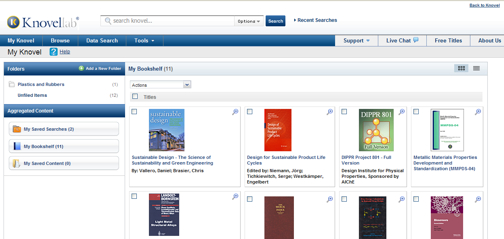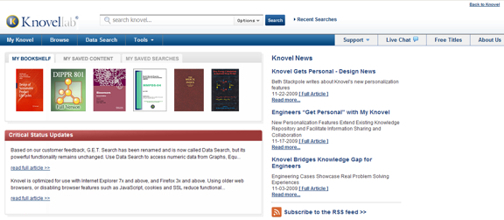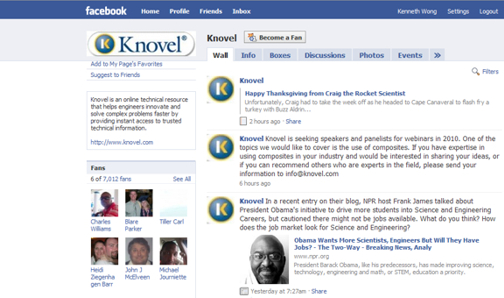Latest News
November 25, 2009


Birds and bees don’t do it, but many engineers do. Despite the widespread availability of portable computing devices, despite the growing movement to digitize printed materials (Google Books Library leads the charge in this), many engineers still prefer to stuff their reference materials—printed periodic tables, dogeared chemistry textbooks from their schooldays, article clippings, and so on—into a ring binder or a file folder. This curious habit didn’t escape the notice of the creators of Knovel, an online technical information portal.
With the launch of My Knovel, a personalization feature for subscribers, Knovel officials are hoping to entice you to do away with your ring binder once and for all. My Knovel is currently available in Knovel Lab, a separate part of Knovel’s portal where the company exposes new features to users before incorporating them into the main site.
Just as Amazon.com allows you to navigate the site through a personal start-up page built from your purchase and search histories (for instance, John Smith’s Amazon.com), Knovel lets you navigate the site through your saved search results; your personal bookshelf, which houses the titles you’ve previously consulted; and your saved content, which may contain links to dynamic tables and equations available within certain tittles.
Currently, you can only aggregate content available from Knovel’s knowledge repository in your bookshelf, but, according to company CEO Chris Forbes, “Over time, you’ll be able to add content of any type from anywhere, including [your] own personally produced content, and store it in a space, which will be held in essence in a Knovel cloud so you can carry it anywhere with you—fully portable from college to job to retirement.”
With build-in personalization, Knovel is well-positioned to introduce social networking features, such as allowing subscribers who repeatedly consult the same reference manual to become friends and share bookshelves. Company officials acknowledge such a feature has been mentioned in the user wish-lists they received, but cannot confirm if or when its development team will pursue it.
Next to the Knovel portal, populated with searchable technical documents, the company also maintains several blogs and a thriving Facebook fan page. With more than 7,000 fans subscribing to its feeds, Knovel’s Facebook page has a following that nearly doubles Autodesk University‘s (3,340) and nearly triples SolidWorks group‘s (2,430).
One of the popular features on Knovel’s Facebook page is, “Stump the Knovel Experts” (under the discussion panel), where you may pose questions ranging from the insane to the serious and get responses. One asked, “Where did the width of rail road tracks originate?” The expert replied, “There are unsubstantiated claims that the origin of this length comes from the width of Roman Chariots ...”
Though the feature is meant for trivia questions related to “Chemical, Civil, Electrical, or Mechanical Engineering” (as the description states), it doesn’t stop someone from inquiring, “How can I be rich applying a financial model?”
For more on Knovel, read “Knovel + Mathcad = Live Equations,” July 16, 2009.

Subscribe to our FREE magazine, FREE email newsletters or both!
Latest News
About the Author
Kenneth Wong is Digital Engineering’s resident blogger and senior editor. Email him at [email protected] or share your thoughts on this article at digitaleng.news/facebook.
Follow DE





